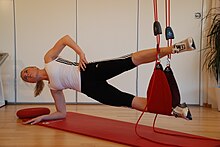Body tension
Body tension describes the physical (basic) tension that a person needs in order to be able to hold and move . It represents a concept that describes the physical condition of the human body (especially its muscles ) statically and in motion and is used in the areas of sport , movement therapy , dance and artistry . Body tension is generally considered to be the basis for performing all kinds of movements effectively and optimally . It is often assumed that good body tension also provides prophylaxis against a number of sports injuries (twisting ankle, stumbling, etc.). Although this property is assumed to be desirable and desirable for many movement arts, commonly used descriptions or explanations of this term differ from one another.
Problems of definition of body tension
Between the two opposites of complete relaxation and complete tension of all muscles, an optimum can be found in which the body, or a part of the body, is held with a minimum of effort , or a planned movement is carried out precisely.
A problem with the definition arises from the fact that every art of movement that requires body tension describes and evaluates it from the respective point of view of the discipline being carried out.
Effects observed
For example, the desired graceful arm posture in ballet cannot be achieved without body tension. However, the extremely long holding must be carried out in such a way that the dance figures are not cramped, but flow smoothly and harmoniously. In adagio acrobatics , some of the figures used can also be performed without body tension, but they clearly suffer in their beauty and elegance . If there is too little tension or too little muscle tone , balance can still be found in many figures by centered standing , but the execution looks much less elegant and the supporting partner requires a multiple of strength and skill. If, on the other hand, the optimal body tension is replaced with too much force, i.e. massive tension, the loads are so high that the stamina is not sufficient to perform a normal sequence of figures.
Body tension and a person's charisma
Low body tension generally conveys uncertainty about posture , limp hands when gesticulating appear insecure, sloping shoulders show no self-confidence. When it comes to communication, people without tension are also perceived as unimpressive; other people who appear insecure do not seem to use muscles for their movements.
Learning body tension
Often people are looking for a method to learn body tension as quickly as possible. Training as a ballet dancer is one of the safest, but not necessarily one of the fastest options. In general, after a very long period of practice in every sport, the necessary proportion of body tension is gradually achieved as a side effect of training.
The simplest basics can be achieved with tension exercises similar to the push-up position (also known as a wheelbarrow) by lifting the feet. Here, the partner who lifts their feet also corrects their posture at the same time. The disadvantage of such exercises is that, although isolated skills are trained with them, there is still no significant transfer to the overall system.
Frequently mentioned exercises
- Slope scale
- on both arms and one bent leg
- with both arms and support on the hips (see above)
- with both arms and support on the feet (see above)
- Board (fully stretched body) with supports on shoulders and feet
- on pedestals
- on partners / worn
- Side support
- Double push-up (upper person rests on the hands of the UP)
- The acrobatic figure "Aviator on his feet" (the lower person lies on their back and the upper person balances on their feet, the hands are grasped here), if one leg is removed here, a complex compensatory movement must take place. The exercise can be increased by holding on with arms crossed.
Illness symptoms, illnesses
One symptom of the conversion disorder is the unwanted, constantly recurring body tension due to psychological tension / constant stress . Another clinical picture is the stiff-man syndrome ; both are neurological diseases.
See also
- Eutonie , a movement pedagogical program with the aim of finding your own rhythm in everyday life and achieving greater balance.
- Qi, Martial Arts Section - i. w. S. Control over life energy.
- Anticipation in sport - the mental anticipation of a future sequence of movements.
- Explosive strength , reactive power , plyometrics , as to muscle tension and ~ expansion.
Individual evidence
- ↑ Tension and charisma
- ↑ http://www.gesundundmunter.at/fileadmin/material/07_Koerpersspannung.pdf Exercises for body tension, PDF 205.77 kB, accessed on February 29, 2016
Web links
- Exercises for climbers focusing on the strength of the arms and core muscles
- Basic exercises for body tension in school lessons including didactic considerations
- Body tension in occupational therapy


